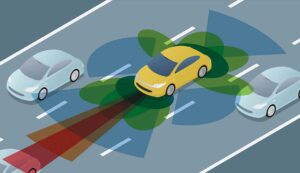5 Innovative Safety Features That Are Revolutionizing Vehicle Safety
When it comes to driving, safety should always be a top priority. With advancements in technology, vehicle manufacturers are constantly coming up with new and innovative safety features to keep drivers and passengers safe on the road. In this article, we will take a closer look at five of the newest safety features that are revolutionizing vehicle safety.

1. Automatic Emergency Braking (AEB)
One of the most significant advancements in vehicle safety is the introduction of automatic emergency braking (AEB). This feature uses sensors and cameras to detect potential collisions and automatically applies the brakes to prevent or reduce the impact of a crash. AEB has been proven to significantly reduce the number of rear-end collisions, making it a crucial safety feature for any vehicle.

2. Lane Departure Warning (LDW)
Lane departure warning (LDW) is another safety feature that uses sensors and cameras to monitor the vehicle’s position on the road. If the vehicle starts to drift out of its lane without the use of a turn signal, the system will alert the driver through visual and audible warnings. LDW is especially helpful for tired or distracted drivers, as it can prevent accidents caused by unintentional lane changes.

3. Blind Spot Detection (BSD)
Blind spot detection (BSD) is a feature that uses sensors to monitor the vehicle’s blind spots. If another vehicle is detected in the blind spot, the system will alert the driver through visual or audible warnings. This feature is particularly useful for highway driving, where changing lanes can be risky. BSD helps to reduce the number of accidents caused by blind spot errors, making it a valuable safety feature for any vehicle.

4. Adaptive Cruise Control (ACC)
Adaptive cruise control (ACC) is an advanced version of traditional cruise control. This feature uses sensors and cameras to maintain a safe distance between the vehicle and the one in front of it. If the vehicle in front slows down, ACC will automatically adjust the speed to maintain a safe following distance. This feature is especially helpful in heavy traffic, as it reduces the risk of rear-end collisions caused by sudden braking.

5. Rear Cross-Traffic Alert (RCTA)
Backing out of a parking spot can be a nerve-wracking experience, especially in busy parking lots. Rear cross-traffic alert (RCTA) is a safety feature that uses sensors to detect vehicles approaching from the sides while the vehicle is in reverse. If a vehicle is detected, the system will alert the driver through visual and audible warnings. RCTA helps to prevent accidents caused by blind spots and makes reversing out of parking spots much safer.
In addition to these five innovative safety features, there are many other advancements in vehicle safety that are worth mentioning. For example, some vehicles now come equipped with a 360-degree camera system, providing drivers with a complete view of their surroundings. This feature is especially helpful for parking and maneuvering in tight spaces.
Another noteworthy safety feature is the tire pressure monitoring system (TPMS). This system uses sensors to monitor the air pressure in each tire and alerts the driver if any tire is underinflated. Properly inflated tires are crucial for safe driving, and TPMS helps to prevent accidents caused by tire blowouts or loss of control due to low tire pressure.
In conclusion, vehicle safety is constantly evolving, and these five innovative safety features are just a few examples of how technology is revolutionizing the way we drive. As a driver, it is essential to stay informed about these advancements and consider them when purchasing a new vehicle. Remember, safety should always be a top priority on the road, and these features can help make your driving experience safer and more enjoyable.
The Latest Safety Features You Need to Know About for Your Next Car Purchase

When it comes to purchasing a new car, safety is always a top priority. With advancements in technology, car manufacturers are constantly adding new safety features to their vehicles. These features not only provide peace of mind for drivers and passengers, but they also play a crucial role in preventing accidents and reducing the severity of injuries. In this article, we will take a closer look at some of the newest safety features that you should consider for your next car purchase.
One of the most talked-about safety features in recent years is automatic emergency braking (AEB). This feature uses sensors and cameras to detect potential collisions and automatically applies the brakes to prevent or mitigate the impact. AEB has been proven to reduce rear-end collisions by up to 50%, making it a must-have feature for any car buyer. In fact, the National Highway Traffic Safety Administration (NHTSA) has announced that AEB will become a standard feature in all new cars by 2022.
Another important safety feature to look out for is lane departure warning (LDW). This feature uses cameras to monitor the car’s position on the road and alerts the driver if they are drifting out of their lane without using a turn signal. LDW has been shown to reduce lane departure crashes by 11%, making it a valuable addition to any vehicle. Some cars even have lane-keeping assist, which not only alerts the driver but also helps steer the car back into the correct lane.
In addition to preventing collisions, safety features also play a crucial role in protecting passengers in the event of an accident. One such feature is the advanced airbag system. While airbags have been a standard safety feature for many years, newer cars now have advanced airbags that can adjust their deployment based on the severity of the crash and the size of the passenger. This helps reduce the risk of airbag-related injuries, especially for children and smaller adults.
Another important safety feature to consider is blind-spot monitoring (BSM). This feature uses sensors to detect vehicles in the driver’s blind spots and alerts them with a visual or audible warning. BSM has been shown to reduce lane-change crashes by 14%, making it a valuable addition to any car. Some cars even have rear cross-traffic alert, which uses the same sensors to detect vehicles approaching from the sides when reversing out of a parking spot.
One of the newest safety features to hit the market is adaptive headlights. These headlights use sensors and cameras to adjust the direction and intensity of the light based on the car’s speed, steering angle, and road conditions. This helps improve visibility and reduce glare for both the driver and other vehicles on the road. Adaptive headlights have been shown to reduce nighttime accidents by up to 10%.
In addition to these advanced safety features, many cars now come equipped with a range of driver assistance technologies. These include features such as adaptive cruise control, which automatically adjusts the car’s speed to maintain a safe distance from the vehicle in front, and lane-keeping assist, which helps keep the car centered in its lane. These technologies not only make driving more convenient but also help reduce the risk of accidents caused by driver error.
In conclusion, when it comes to purchasing a new car, it is important to consider the latest safety features available. These features not only provide peace of mind but also play a crucial role in preventing accidents and reducing the severity of injuries. From automatic emergency braking to adaptive headlights, there are many advanced safety features to choose from that can make your driving experience safer and more enjoyable. So, the next time you’re in the market for a new car, be sure to keep these safety features in mind.
Spotlight on Safety: Exploring the Newest Features That Are Keeping Drivers Safe on the Road

As technology continues to advance, so do the safety features in our vehicles. From airbags to lane departure warnings, these features are designed to keep drivers and passengers safe on the road. In this article, we will take a closer look at some of the newest safety features that are making their way into cars and how they are helping to prevent accidents and save lives.
One of the most talked-about safety features in recent years is automatic emergency braking (AEB). This feature uses sensors and cameras to detect potential collisions and automatically applies the brakes if the driver does not respond in time. AEB has been proven to reduce rear-end collisions by up to 50%, making it a valuable addition to any vehicle.
Another feature that is gaining popularity is lane-keeping assist. This technology uses cameras to monitor the vehicle’s position on the road and alerts the driver if they start to drift out of their lane. Some systems even have the ability to steer the car back into the correct lane. This feature is especially helpful for tired or distracted drivers who may unintentionally veer out of their lane.
In addition to these advanced safety features, there are also some new developments in more traditional safety features. For example, seatbelts have been a standard safety feature in cars for decades, but now they are becoming even more advanced. Some newer models have seatbelt pre-tensioners, which automatically tighten the seatbelt in the event of a collision, providing even more protection for the driver and passengers.
Another traditional safety feature that is getting an upgrade is airbags. While front and side airbags have been around for a while, newer models are now equipped with knee airbags and even rear-seat airbags. These additional airbags provide extra protection in the event of a crash, reducing the risk of serious injuries.
One of the most exciting developments in safety features is the use of artificial intelligence (AI). AI is being used to create more advanced driver assistance systems (ADAS) that can help prevent accidents before they even happen. For example, some cars now have AI-powered systems that can detect when a driver is becoming drowsy and alert them to take a break. This can be a lifesaver for long-distance drivers or those who have a tendency to doze off behind the wheel.
Another way AI is being used to improve safety is through predictive technology. This involves using data and algorithms to predict potential hazards on the road and warn drivers in advance. For example, if a car suddenly brakes in front of you, the system can detect this and alert you to slow down or change lanes to avoid a collision.
While these new safety features are certainly impressive, it’s important to note that they are not a replacement for safe driving habits. It’s still crucial for drivers to pay attention to the road, follow traffic laws, and avoid distractions while behind the wheel. These features are meant to assist drivers, not replace them.
In conclusion, the newest safety features in cars are truly remarkable and have the potential to save countless lives on the road. From AEB to AI-powered systems, these features are constantly evolving and becoming more advanced. As technology continues to progress, we can only imagine what other safety features will be introduced in the future. But for now, we can rest assured that these features are making our roads safer for everyone. So buckle up, stay alert, and enjoy the ride!




